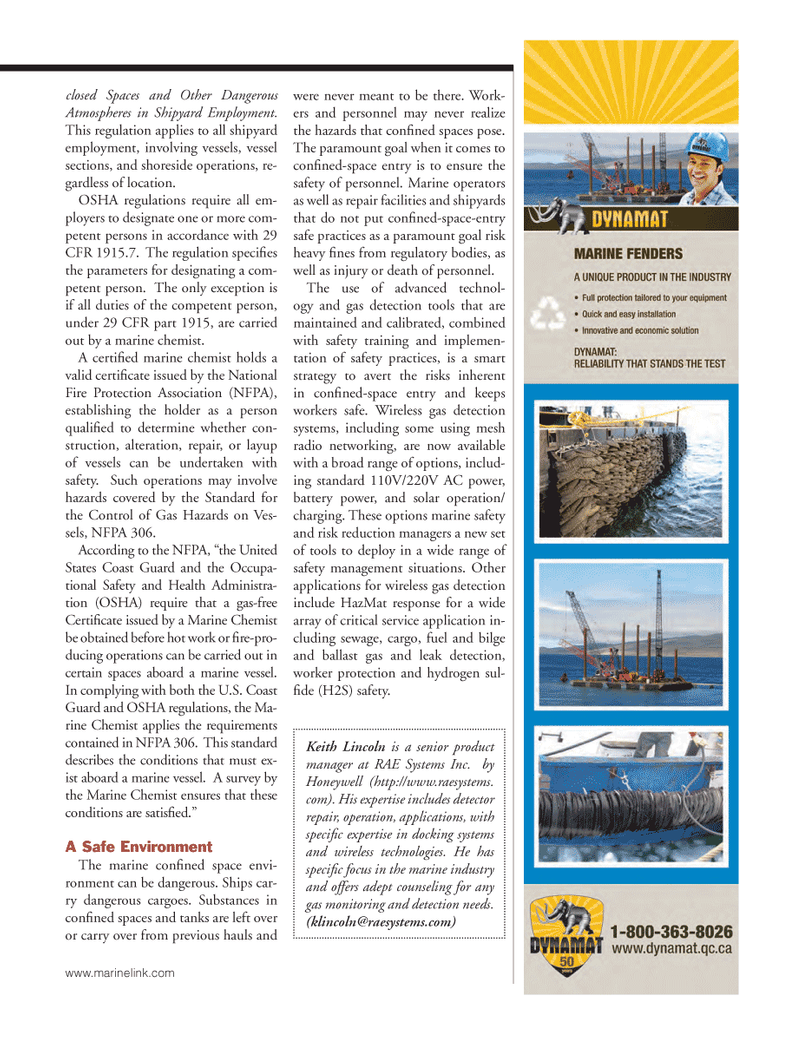
Page 23: of Marine News Magazine (October 2014)
Innovative Products & Boats - 2014
Read this page in Pdf, Flash or Html5 edition of October 2014 Marine News Magazine
closed Spaces and Other Dangerous
Atmospheres in Shipyard Employment.
This regulation applies to all shipyard employment, involving vessels, vessel sections, and shoreside operations, re- gardless of location.
OSHA regulations require all em- ployers to designate one or more com- petent persons in accordance with 29
CFR 1915.7. The regulation specifi es the parameters for designating a com- petent person. The only exception is if all duties of the competent person, under 29 CFR part 1915, are carried out by a marine chemist.
A certifi ed marine chemist holds a valid certifi cate issued by the National
Fire Protection Association (NFPA), establishing the holder as a person qualifi ed to determine whether con- struction, alteration, repair, or layup of vessels can be undertaken with safety. Such operations may involve hazards covered by the Standard for the Control of Gas Hazards on Ves- sels, NFPA 306.
According to the NFPA, “the United
States Coast Guard and the Occupa- tional Safety and Health Administra- tion (OSHA) require that a gas-free
Certifi cate issued by a Marine Chemist be obtained before hot work or fi re-pro- ducing operations can be carried out in certain spaces aboard a marine vessel.
In complying with both the U.S. Coast
Guard and OSHA regulations, the Ma- rine Chemist applies the requirements contained in NFPA 306. This standard describes the conditions that must ex- ist aboard a marine vessel. A survey by the Marine Chemist ensures that these conditions are satisfi ed.”
A Safe Environment
The marine confi ned space envi- ronment can be dangerous. Ships car- ry dangerous cargoes. Substances in confi ned spaces and tanks are left over or carry over from previous hauls and were never meant to be there. Work- ers and personnel may never realize the hazards that confi ned spaces pose.
The paramount goal when it comes to confi ned-space entry is to ensure the safety of personnel. Marine operators as well as repair facilities and shipyards that do not put confi ned-space-entry safe practices as a paramount goal risk heavy fi nes from regulatory bodies, as well as injury or death of personnel.
The use of advanced technol- ogy and gas detection tools that are maintained and calibrated, combined with safety training and implemen- tation of safety practices, is a smart strategy to avert the risks inherent in confi ned-space entry and keeps workers safe. Wireless gas detection systems, including some using mesh radio networking, are now available with a broad range of options, includ- ing standard 110V/220V AC power, battery power, and solar operation/ charging. These options marine safety and risk reduction managers a new set of tools to deploy in a wide range of safety management situations. Other applications for wireless gas detection include HazMat response for a wide array of critical service application in- cluding sewage, cargo, fuel and bilge and ballast gas and leak detection, worker protection and hydrogen sul- fi de (H2S) safety.
Keith Lincoln is a senior product manager at RAE Systems Inc. by
Honeywell (http://www.raesystems. com). His expertise includes detector repair, operation, applications, with specifi c expertise in docking systems and wireless technologies. He has specifi c focus in the marine industry and offers adept counseling for any gas monitoring and detection needs. ([email protected]) www.marinelink.com
MN Oct14 Layout 18-31.indd 23 9/18/2014 3:28:50 PM

 22
22

 24
24
